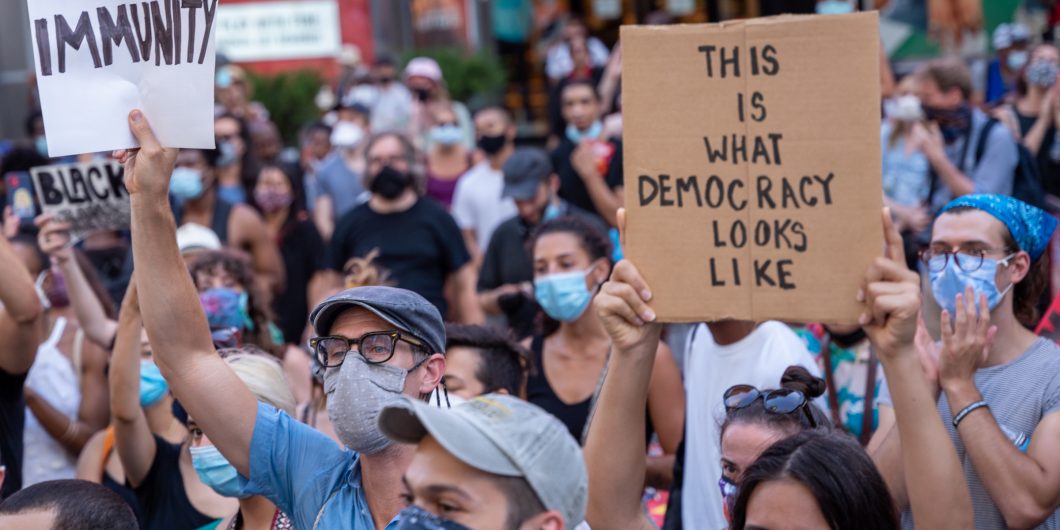Conservatism has hope because many ordinary people are still proud to be patriots, and some remain stalwart people of faith.
The Autocratic Challenge to Democracy
The argument in David Stasavage’s book, The Decline and Rise of Democracy: A Global History from Antiquity to Today, is both more provocative and less sanguine regarding democracy than the title suggests. Despite the title, Stasavage does not present a variant of Whig history where the world inevitably moves toward ever greater realizations of equality and liberal democracy. Democracy, in Stasavage’s telling, is only “a” possibility in human political evolution, and not a necessary one at that. This despite Stasavage making clear, de rigueur, that he of course prefers democracy and, at times, putting his scholarly thumb on the democratic side of the empirical evidence he presents.
Stasavage’s political world offers pretty much only two options, democracy and autocracy. (Unlike Aristotle who treats “oligarchies” as a constitutional form separate from democracy and autocracy, “oligarchies” in Stasavage’s book generally get wrapped into one category or the other, depending on the number of oligarchs relative to the population.)
Stasavage emphasizes early in the book that democracy—defined as systems of government in which rulers “seek consent from those they govern”—“occurs naturally among humans, even if this is far from inevitable.” By democracy being “natural” Stasavage seems to mean that humans have often (but not always) spontaneously formed themselves into democratic communities throughout history. Democracies in human history do not arise merely by “reflection and choice,” to quote Alexander Hamilton in a different context, but also arise naturally, that is “by accident and force.”
But democracies are not the only form of political organization that arise naturally among humans. While Stasavage avoids using parallel language regarding the naturalness of autocracy, he is nonetheless clear from start to finish that autocracy is as natural a human political form as democracy is. For instance: “The story of early democracy and early autocracy points away from a single evolutionary path: it instead shows two very different trajectories of political development . . .”
The signal aspect of Stasavage’s story of human political development is that there is not one trajectory. There are, as it were, multiple equilibria, autocracy as well as democracy. It is this dual focus in the substance of his argument that saves Stasavage’s book from presenting just another kind of Whiggery.
Yet he downplays the edgier implications of this dual result. Seeming to run away from the positivistic results of his analysis, his express research question circles around democracy only. “Where does democracy come from, how is it sustained, and what is its future?” Yet in Stasavage’s analysis, provocatively, democracy does not evolve necessarily out of autocracy, neither in the ancient world nor in modern times. Yet Stasavage underplays the challenge his analysis presents to modern democratic sensibilities. Despite his analysis sketching multiple “different trajectories of political development,” when Stasavage summarizes his analysis he spins it toward democracy, presenting a somewhat more robust case for democracy’s development and sustenance than I take his evidence actually to suggest.
Despite sketching autocracy as a persistent and robust alternative to democracy, Stasavage tends to sketch democracy as having all the attractors relative to autocracy. He explains what these are:
If we agree that early democracy and early autocracy were two alternative paths of political development, then the next question is what led a society down one path as opposed to the other…. early democracy was more likely to prevail when rulers were uncertain about [agricultural] production, when people found it easy to exit, and finally when rulers needed their people more than their people needed them.
My own rephrasing of these conditions is that “early democracies” more likely prevailed when: [1] local residents hold superior information (“asymmetric information”) relative to rulers regarding what their land can produce, [2] people can easily vote with their feet by moving (a “Tiebout“-like condition), and [3] when rulers have goals (for example, fighting the King next door) and cannot simply expropriate resources needed to pursue those goals without provoking an unwanted domestic response.
Stasavage’s first condition associated with the rise of democracy relative to autocracy is that democratic assemblies or councils can provide a comparative informational advantage to rulers relative to bureaucratic/autocratic administration when land conditions within a region were heterogenous. When that condition held, he argues, it induced rulers (at the margin) to institute councils and assemblies as a means to acquire needed information for taxation, thereby promoting the rise of democratic or near-democratic institutions.
Similar arguments are not unknown. James Madison, for example, argues for an informational need of a sufficient number of House members in Federalist 56 for Congress to craft taxes and commercial regulations to local circumstances. Yet, for Stasavage’s developmental argument, it is not entirely clear what set of incentives he posits for representatives relative to bureaucrats that results in the comparative advantage of assemblies to bureaucracies. In particular, why would representatives sincerely report higher-quality land to an assembly when that report would result in higher taxes for that land.
The asserted association between democracy and voting with one’s feet is also curious. As is the norm for political scientists, Stasavage seems to assume that most people want robustly to participate in their own governance. While I have no doubt that many people value participation in self-governance, there are nonetheless decision costs that affect the willingness of people to participate in self-governance. Consider that even in modern democracies, where participation is a minimally-burdensome stop at the polling booth every six months or so, scarcely over half of Americans vote in presidential elections, and even fewer usually vote in state and local elections. Political systems that require even greater levels of political participation necessarily increase the cost to self-government. It may be heresy in the academy, but not everyone so values political participation as to be willing to pay the cost.
So, too, scholars regularly conflate the results of being able to “vote with one’s feet” with actual voting. Yet while the Tiebout dynamic stems from freedom of movement, it does not map onto internal political organization. This ties together freedom of movement with Stasavage’s third condition, the capability of a ruler to expropriate the people for the ruler’s own goals. Ease of exit and entry limit the possibility of even autocratic rent extraction, thereby actually making autocracy more attractive to the populace rather than less.
Jim Crow, for example, arose in the South because of majoritarian political preferences, not in spite of them. Stasavage sidesteps the breadth of the problem of majority faction by focusing attention on today’s excoriated minority of the wealthy.
The upshot is this: with Stasavage putting his thumb on the scales in favor of democracy misses the possible virtues of autocracy in his comparative theory. For him, humans flee autocracy if they have the chance. Yet that seems more to reflect today’s democratic sensibilities more than historical reality. Think, for example, of the very earnest autocratic fevers of the 1920s and 1930s, and not simply within Italy and Germany, among British and American elites as well. Or consider the often fawning treatment of the Chinese model of state-capitalism in the pre-Trump era. And, today, hundreds of thousands of expats from the democratic West quite happily choose to live and work in autocratic political systems across the world.
This raises an uncomfortable challenge for modern democrats, uncomfortable because today is a time in which “democracy” is a godterm. Yet, at times in the past and present, people have been attracted to autocracy over democracy because autocracies can provide efficient decision-making and energetic government relative to democracy. To be sure, these benefits need to be weighed against the level of extraction an autocrat might impose on the population. And yet that, in turn, would be related to ease of exit and entry on the part of the population, among other things. Yet surely positive political science requires that we recognize the possibility that people under some circumstances might prefer to live in a well-run autocracy.
And then Stasavage minimizes other costs to democracy. In particular, he ignores the full breadth of the threat of majority tyranny. He does recognize, and dismisses, the classic concern with democracy that popular majorities would use their power to expropriate the wealthy, and so destroy their economies. Yet he all but ignores other forms of factionalism, not least temptations majorities have to oppress racial, ethnic, and religious minorities. Jim Crow, for example, arose in the South because of majoritarian political preferences, not in spite of them. Stasavage sidesteps the breadth of the problem of majority faction by focusing attention on today’s excoriated minority of the wealthy.
Finally, then there is Stasavage’s simple dualism itself: democracy or autocracy. Oligarchy does not exist in Stasavage’s political world except in passing. While he occasionally nods to the oligarchic possibility, Stasavage generally defines any political system with a council or assembly as democratic. At least he resolves any doubt in favor of the democratic label. This despite the possibility that the council or assembly with which a ruler interacts, and whose consent the ruler needs, could very well be an oligarchic institution rather than a democratic one. This results in Stasavage seemingly sweeping a host of governments into the democratic category when they might more properly be designated as non-democratic oligarchies instead.
Stasavage’s analysis would have been helpfully complicated by adopting Aristotle’s set of three basic types of rule: rule by the one, by the few, and by the many. He could have deepened his argument further still by recognizing that all three forms have both a proper form and deviant form. The classic organization would avoid Stasavage’s oversimplified set of political possibilities, and would have conceded the possibility of “proper” or attractive forms of autocracy as well as of democracy.
Yet despite these weaknesses, Stasavage has written a fascinating book. His encyclopedic treatment of ancient and non-Western political forms is impressive, and the evidence he adduces that bureaucracy is the handmaiden of autocracy in early democracies (well, except when it isn’t) deserves additional attention in light of the rise of bureaucratic government in modern democracies. Most of all, however, while Stasavage summarily weights the evidence in support of democracy, he is a good enough scholar that the evidence he accumulates in the book actually speaks to the big question of democracy in this age: Whether democracy truly merits the unquestioned, and unquestionable, faith with which modern Westerners have invested it.



